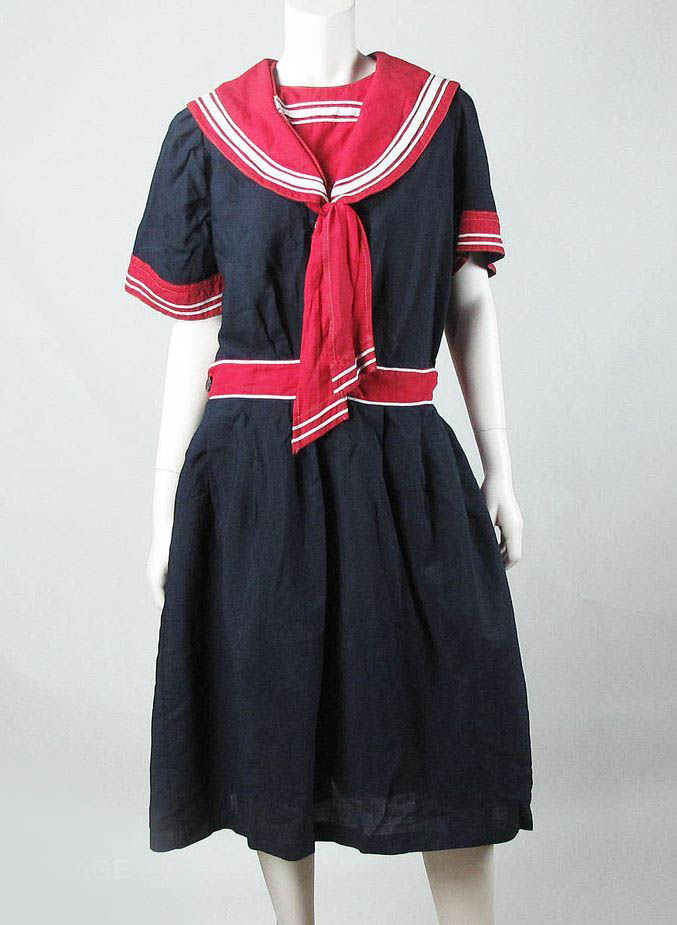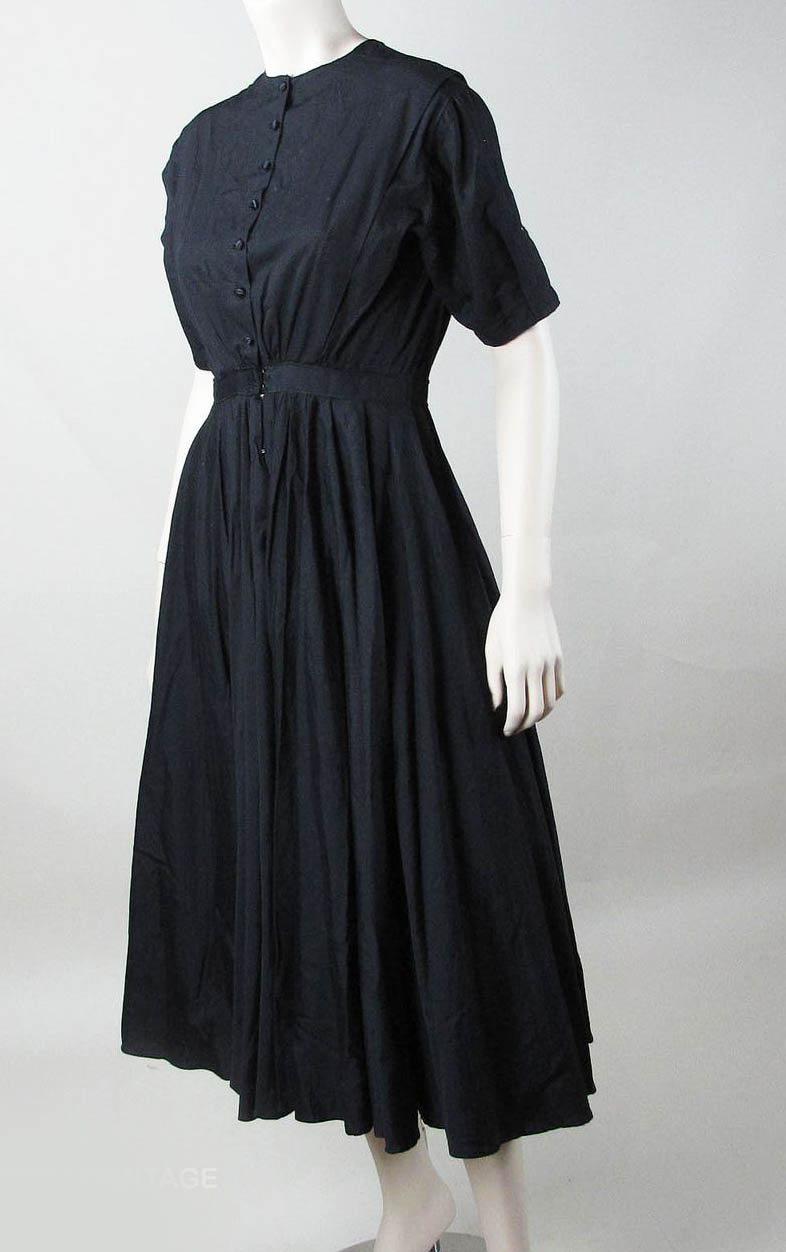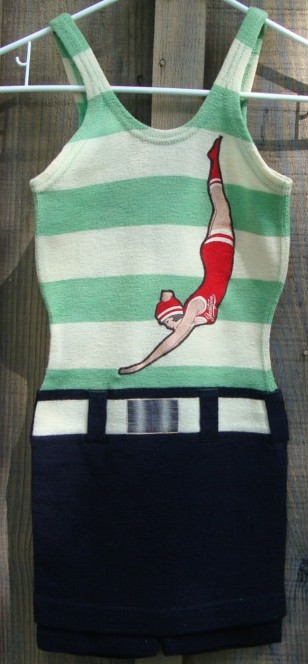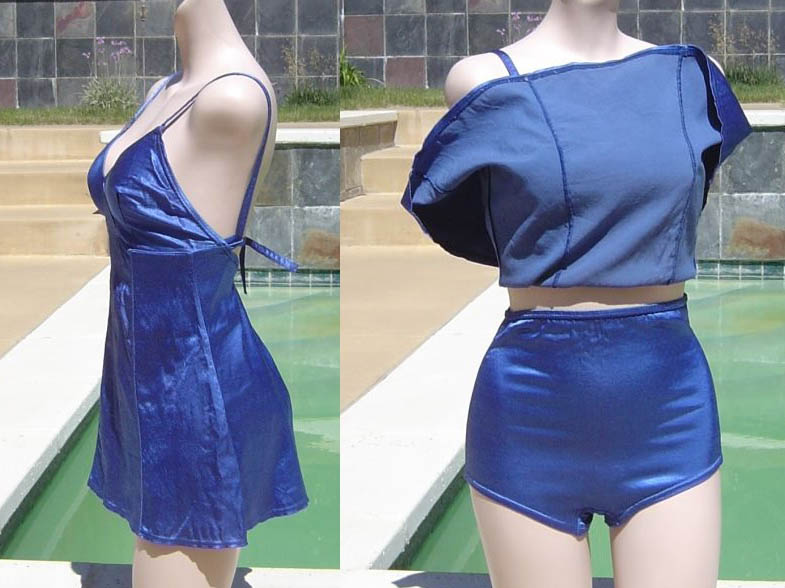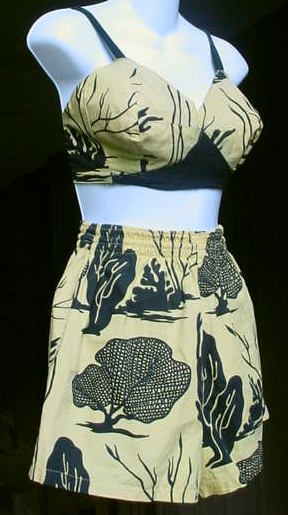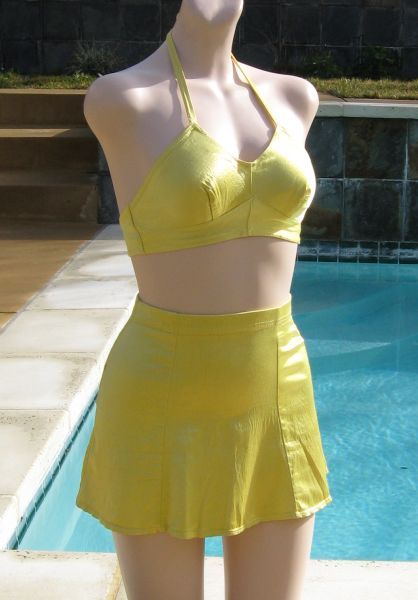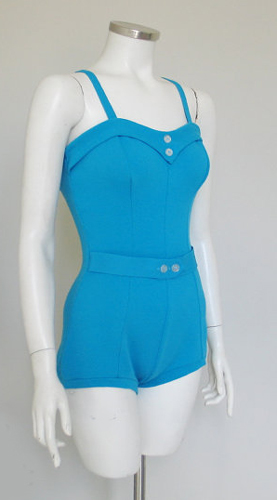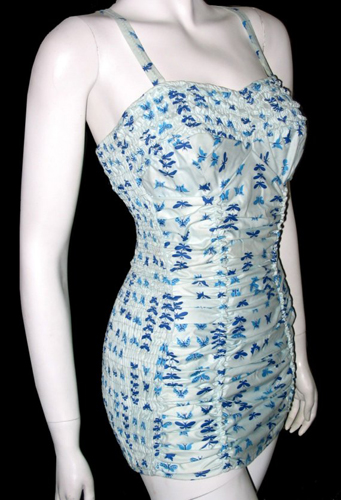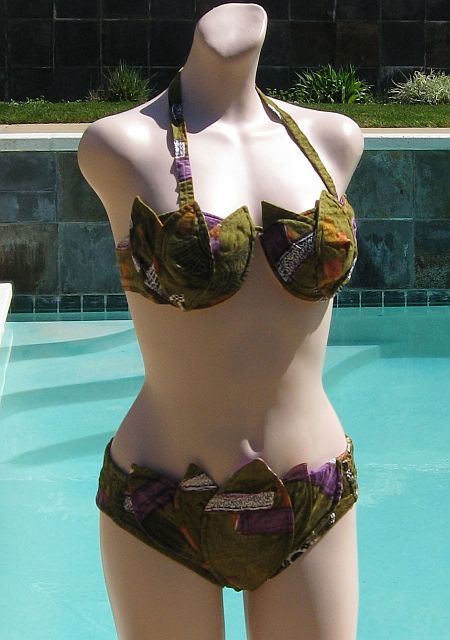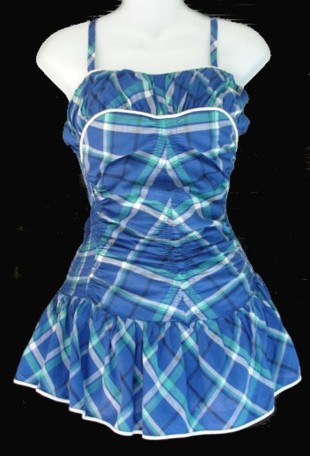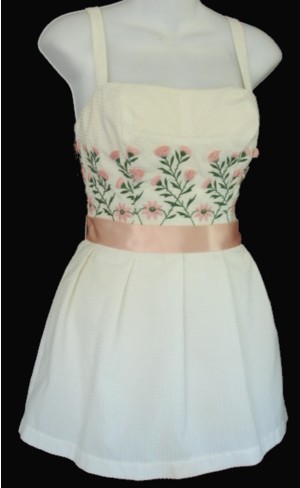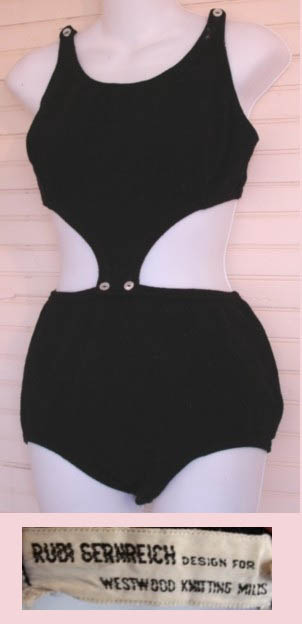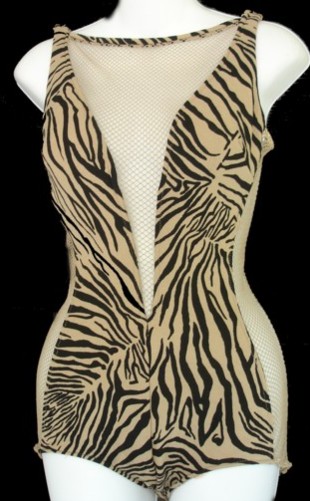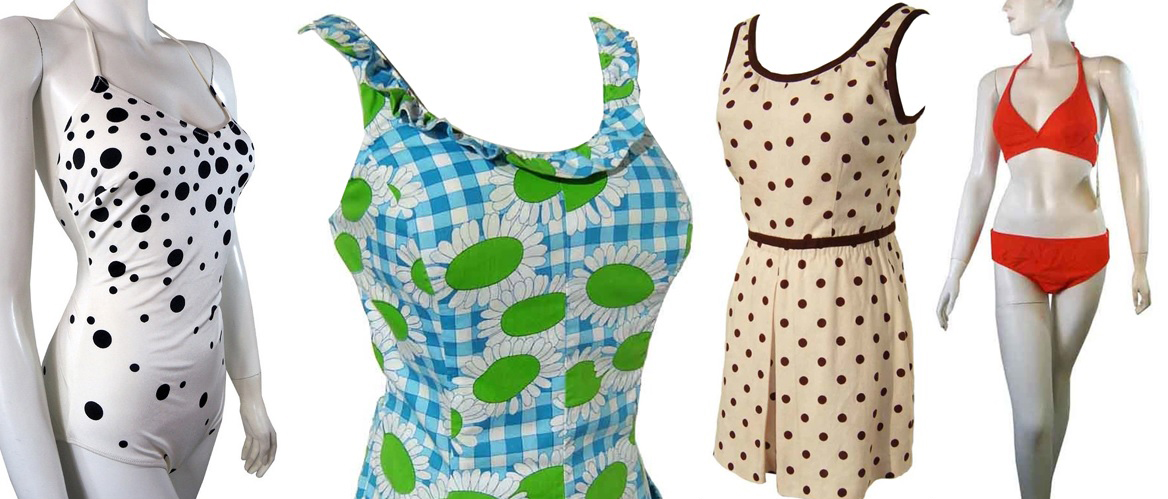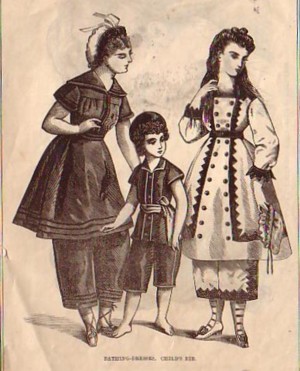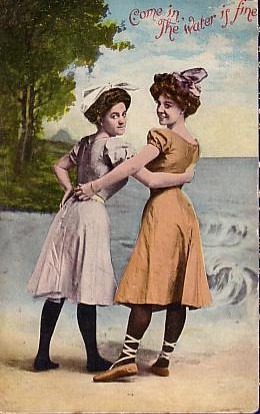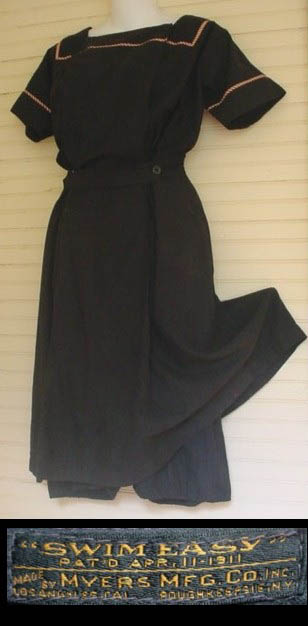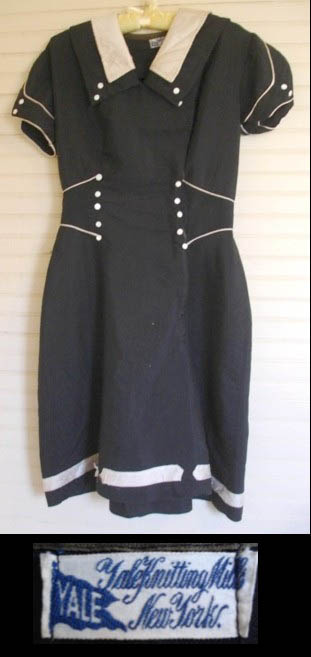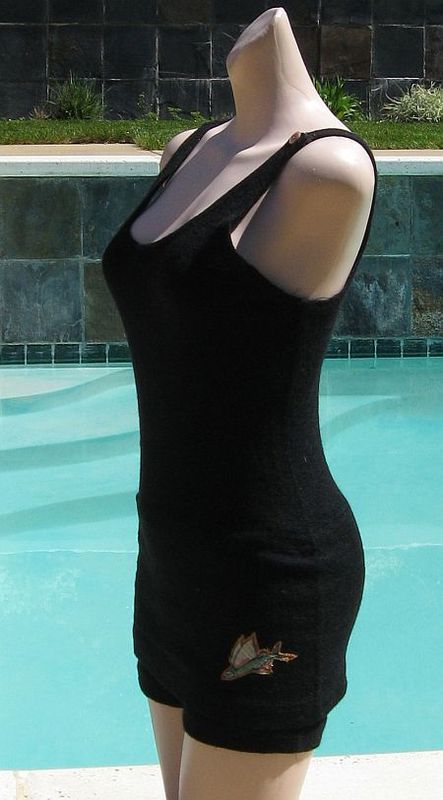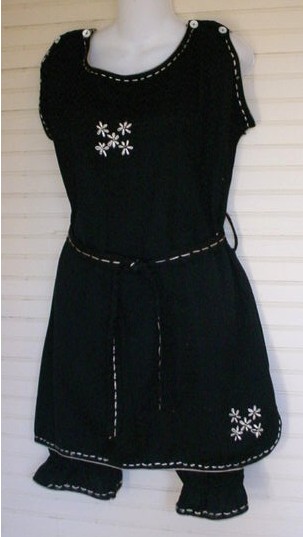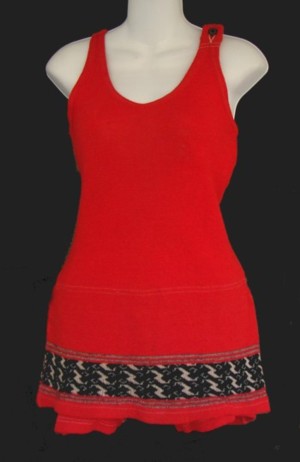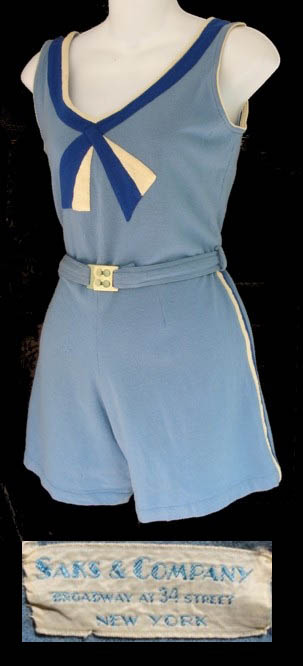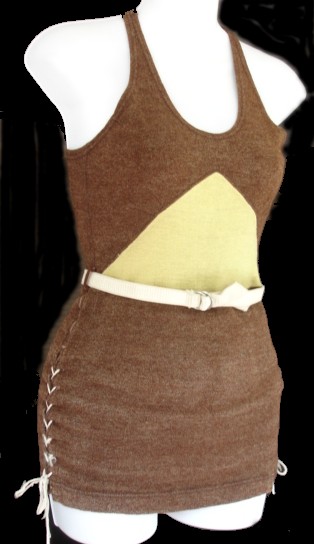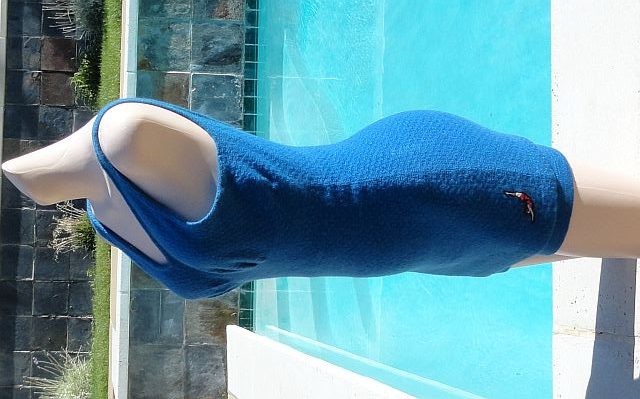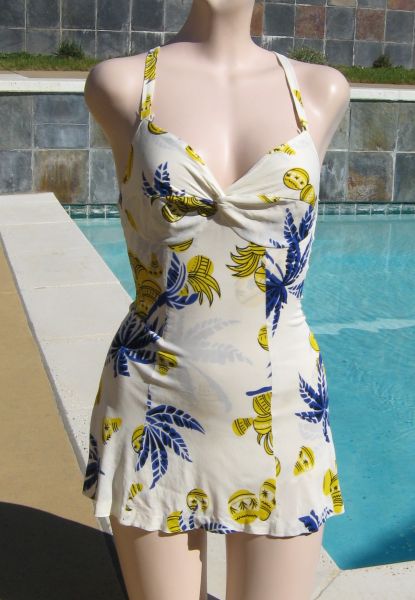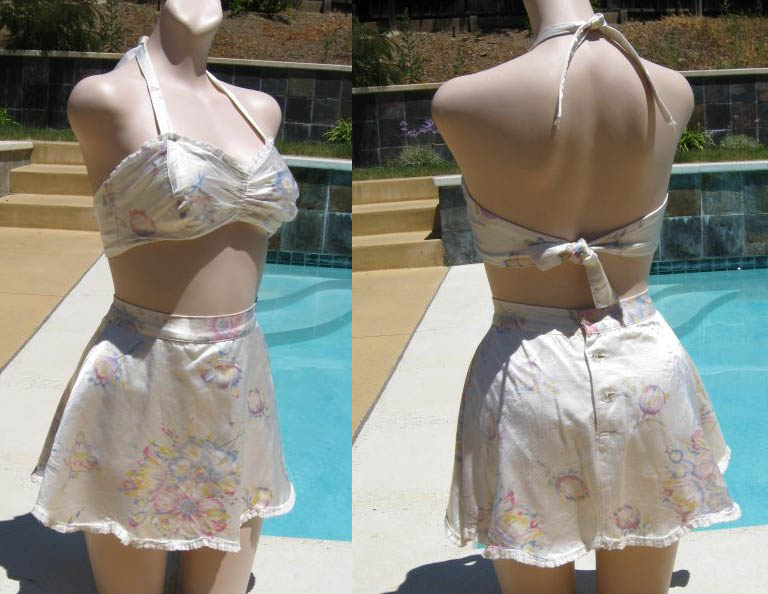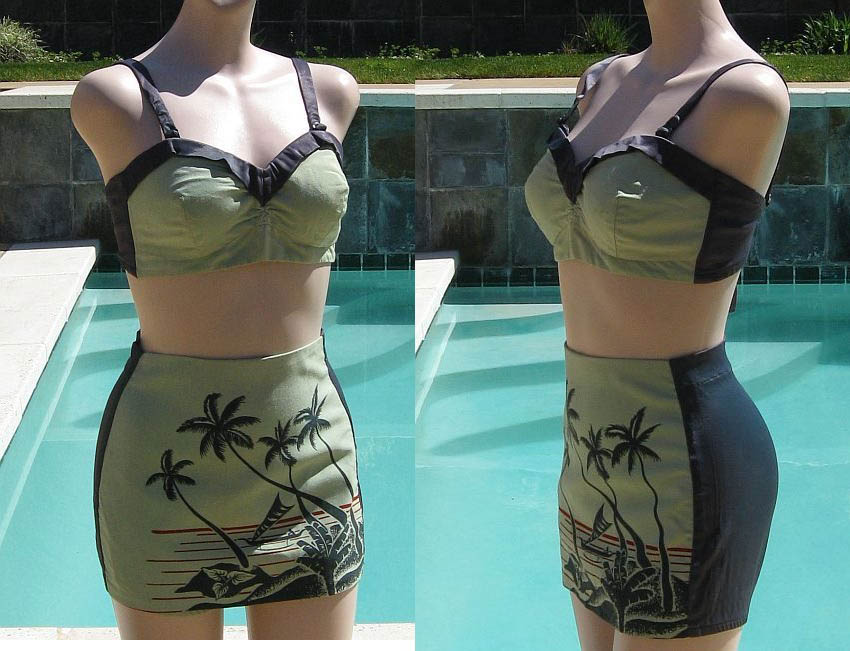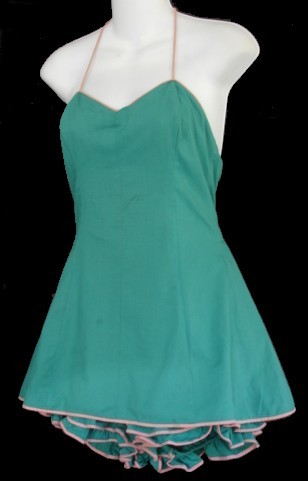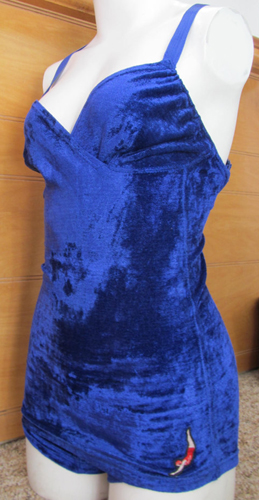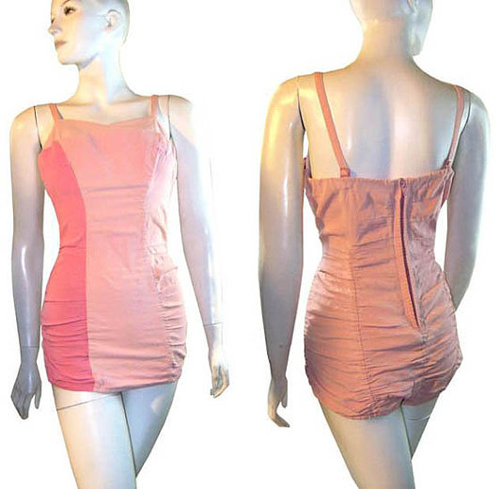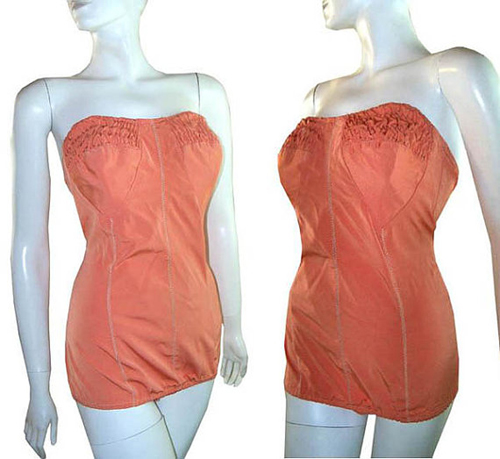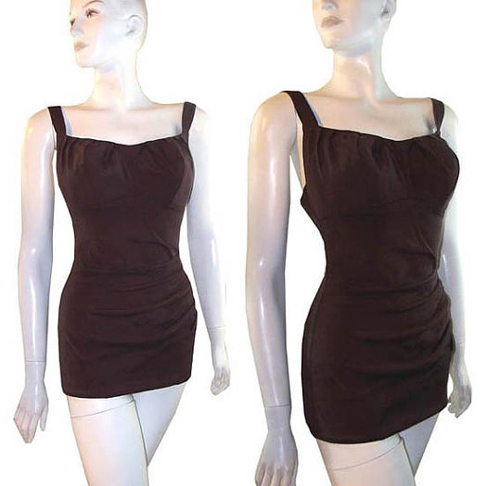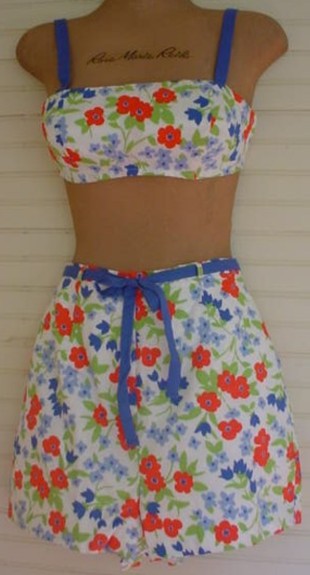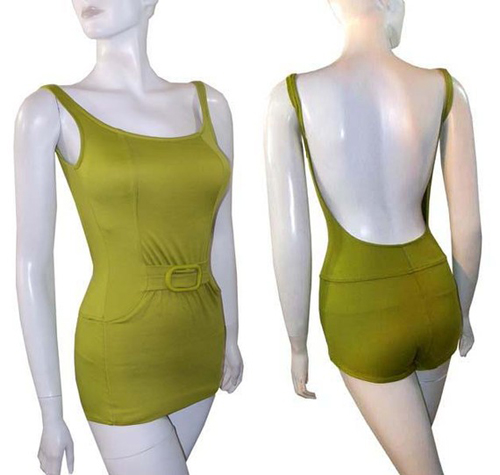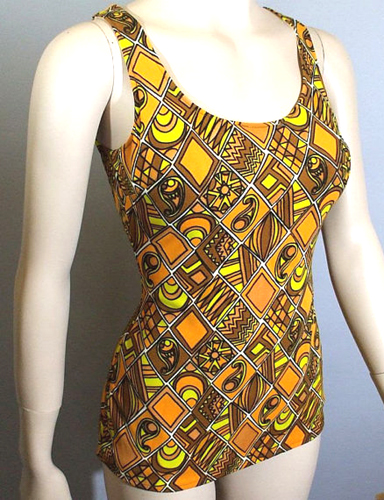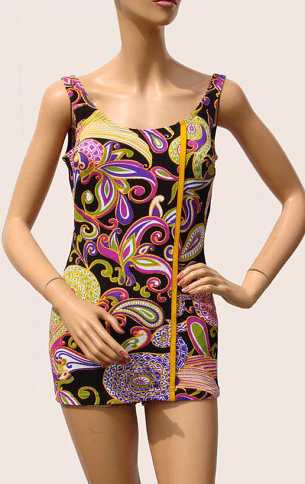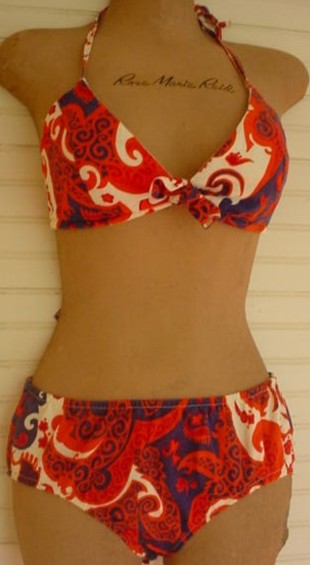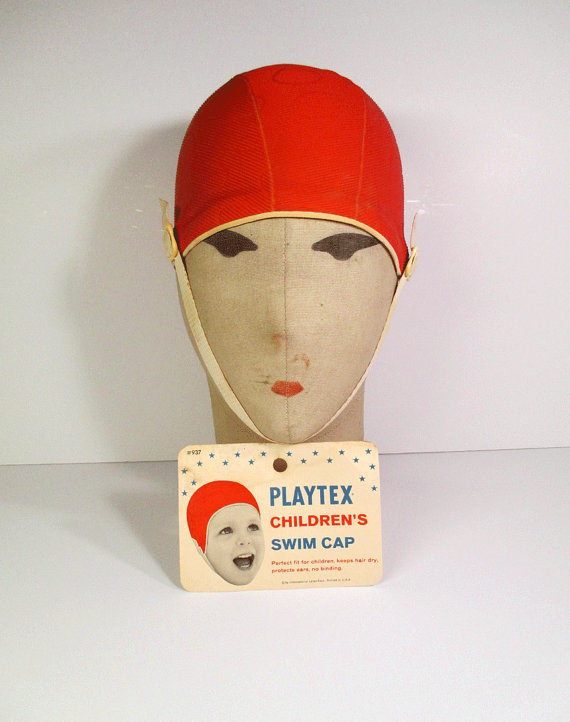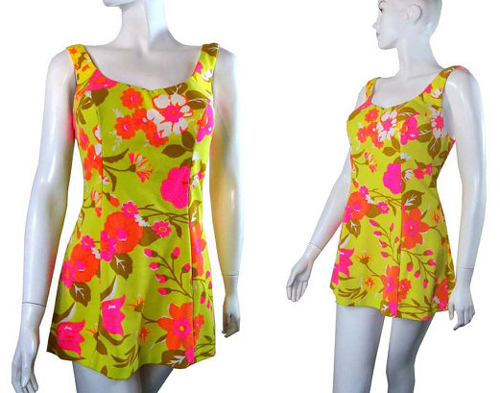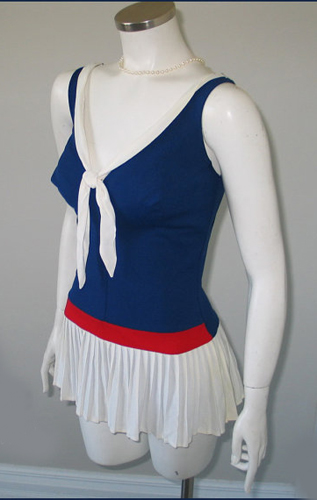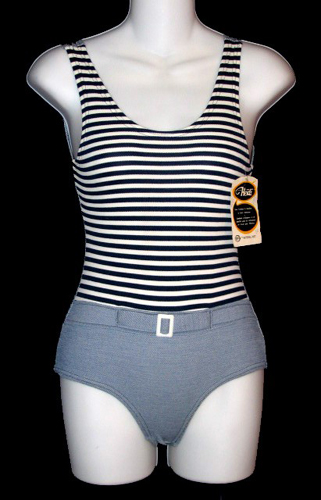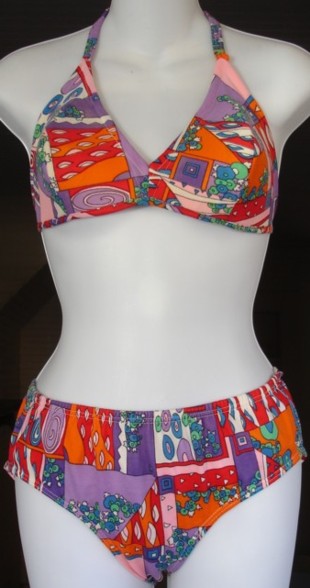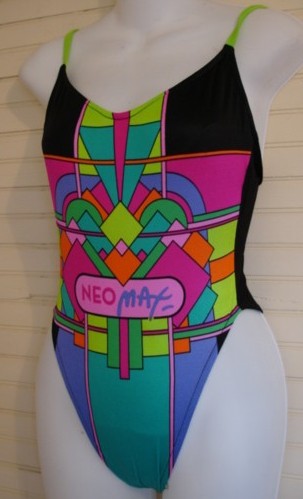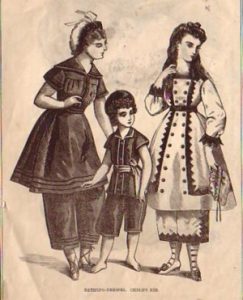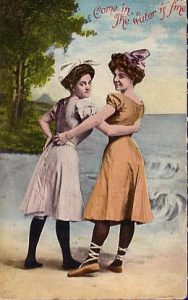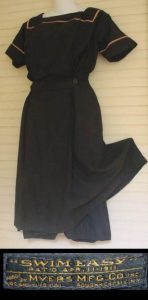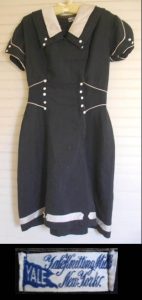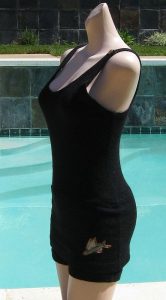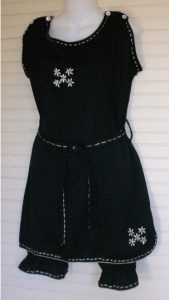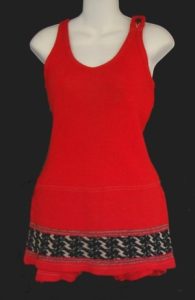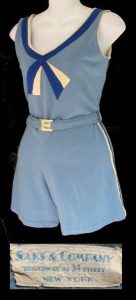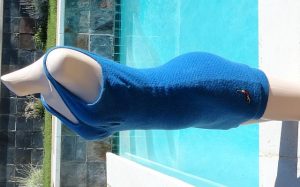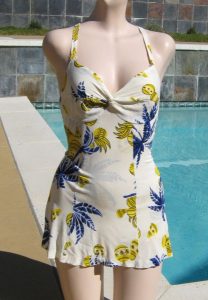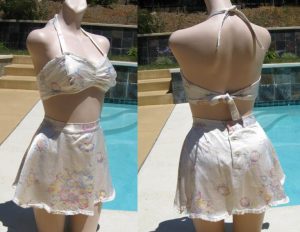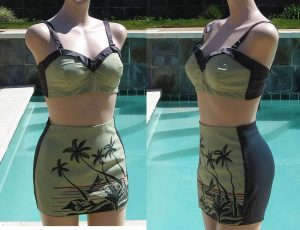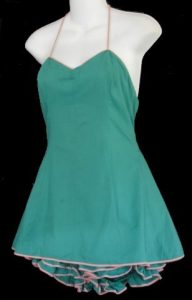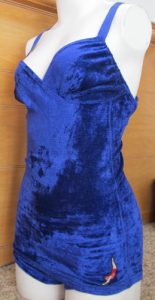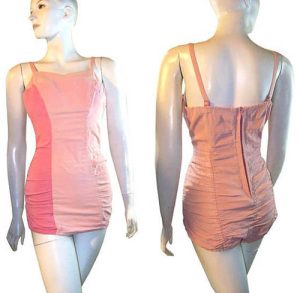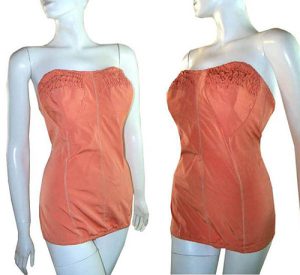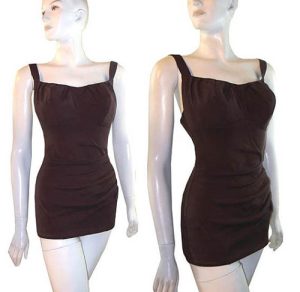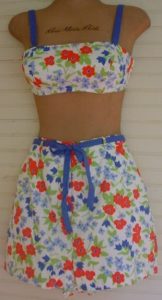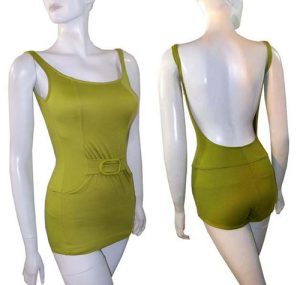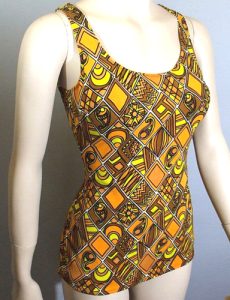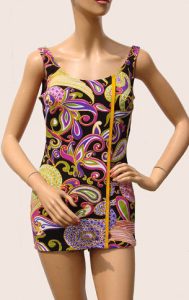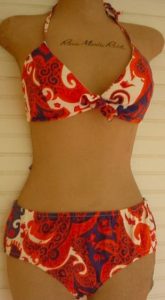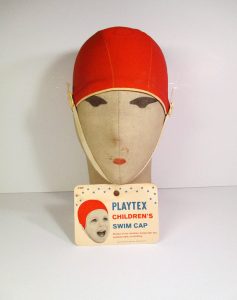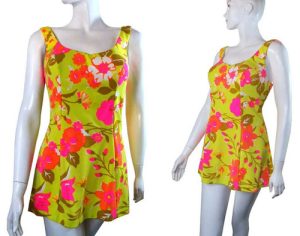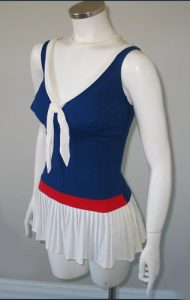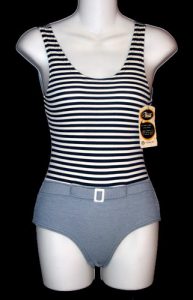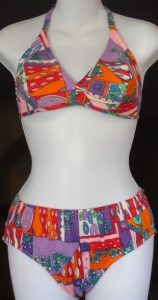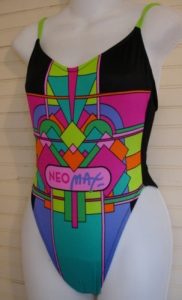See women’s swimwear from VFG members on Etsy (paid link)
See men’s swimwear from VFG members on Etsy (paid link)
You may think that the body-baring bikinis of today would have shocked the world centuries ago but you’d be wrong. Actually today’s swimwear is rather similar to that which was worn in ancient Greece as far back as 300 BC. As pictured on mosaic walls, ancient Greek women were barely covered by pieces of fabric, much like the scanty bikinis of the 20th century!
During the Roman Empire, the communal bathhouse was an important neighborhood gathering place. Here business was discussed and gossip shared in pleasurable surroundings that offered the luxury of oil and water, hot and cold baths while you chatted. After the fall of the Roman Empire, bathing was no longer considered a recreational pastime in western society and was reserved for therapeutic use only.
Years later ‘spas’ began to reappear in European towns like Bath in England and Germany’s Baden Baden, at which men were segregated from women.
Even though females couldn’t be viewed by the male gender, they were still concerned about their modesty, so bathing dresses were donned. To prevent the skirts from rising up around the body when entering the water, hems often had weights sewn into them. The suits were worn with heavy dark stockings and for extra caution, many were also worn with long knickers or bloomers.
It was not until the mid 1800s that swimming at the seaside was considered to be a form of relaxation and enjoyment. New rail systems transported holidaying Victorian families to the coast.
To preserve female modesty bathing machines were developed that were effectively changing rooms on wheels. This enabled them to be pulled by horses into the sea, allowing females to be on show as little as possible as they emerged for a dip. Young men would take up position along the pier to peek through telescopes (intended for scenic edification) in order to catch a glimpse of forbidden delights.
Not that there was much delight to be had, Victorian costumes were the ultimate in cover up, at least while they were dry. Once wet, the woolen fabric clung to the body removing the need for a vivid imagination. The weight of the sodden wool also turned swimming into a bit of a challenge.
Mixed bathing became acceptable at the turn of the 19th and 20th centuries. Edwardian ladies even took to walking openly along the beach while in their costumes.
Annette Kellerman created quite the uproar in 1907, which led to her arrest. Her crime was to appear at Boston’s Revere Beach in a one-piecing bathing suit that revealed her arms, legs and rather a voluptuous body!
The first annual ‘bathing suit day’ was held at Madison Square Garden on May 16, 1916 and shortly afterwards beauty contests became common where participants showed off their physique in a bathing suit.
In 1921 Jantzen Knitting Mills launched the first one-piece ‘elastic’ suit that immediately gained popularity with the Bathing Beauty Pageant that was held in Atlantic City.
For the next 15 years, wool knit swimming suits were worn by both men and women.
In 1920 they covered the wearer from the neck to almost the knees, but as time went on, the swimsuit got smaller and smaller.
Knitted wool swimsuits were eased into history in the mid 1930s when California swimsuit maker Mabs of Hollywood began to fashion swimwear from Lastex, a woven satin finish elastic and silk material first used for girdle manufacture.
Mabs made sure of its success by making suits for Joan Crawford, Loretta Young, and Jean Harlow.
When Marlene Dietrich wanted one too and went into Bullocks department store to order a dozen in every colour, the day of the knitted suit came to an abrupt end.
In 1946, designer Louis Reard was obliged to hire Micheline Bernardini (an exotic dancer at the Casino de Paris) to model his latest creation – the ‘Bikini’ – because his regular models flatly refused to wear it.
The introduction of Reard’s bikini (named after Bikini Atoll in the South Pacific where atomic bomb testing had taken place) caused quite a stir in the United States.
That was nothing, however to the reaction in predominantly Catholic European countries, including Italy and Spain, where the powers that be actually banned women from wearing bikinis on their beaches!
Although Reard was credited as having introduced the bikini, Jacques Heim had actually presented his version of the bikini, which he called the ‘Atome’ in the same year.
Yet even Heim’s ‘Atome’ wasn’t the first swimsuit that bared the female midriff. Only three years earlier, the U.S. government had passed legislation for a ten percent reduction in the fabric content of woman’s swimwear as part of the war effort.
The obvious (and only decent) saving was made by removing the mid section of the one-piece costume. Whether this reduction helped win the war is debatable. However, it certainly boosted the morale of soldiers on leave as they watched the patriotic promenading along public beaches.
Three of the top names in American swimwear all started out as knitwear companies. Portland Knitting Mills became Jantzen, West Coast Knitting mills made the Cole of California swimsuits and Catalina swimwear was produced by Bentz Knitting Mills, later to rename themselves Pacific Knitting Mills.
For many years swimwear was knitted from wool and each of these companies found ways of incorporating a form of elastic, known as Lastex into the weave, which resulted in a more figure-hugging and flattering garment. Many of the big swimwear companies developed their own form of Lastex and claimed a patent. Cole’s was Matletex, and the company went on to develop a version of Spandex, originally devised by DuPont who patented the trade name Lycra.
Fred Cole secured the services of famous swimming Hollywood star Esther Williams to promote his swimwear in the early 1950’s. Cole himself was a product of Hollywood having been a silent movie star in the 1920’s before entering the swimwear industry, via West Coast Knitting Mills which was owned by his parents.
Using his Hollywood contacts to the full introduced him to designer Margit Felligi, who joined Cole in 1936 and maintained her design leadership for the company for the next thirty-six years. During this time she created such note-worthies as the Swoon and the Scandal suit.
The first was a product of the war years and was made from parachute silk (the company made parachutes for the government) and the second was a one-piece, launched in the mid-60’s that had net-panels on its front and sides. This gave the viewer more than just a peak at the body underneath. Cole’s daughter Anne followed in his footsteps and became one of the most famous swimwear designers.
Cole even persuaded Dior to design a swimwear collection for the company in 1955. At first Dior was reluctant, pleading that he knew nothing of swimwear to which Cole responded “You’re a designer aren’t you? So design.’ Not being able to argue with that logic Dior complied and produced his one and only swimwear collection.
Catalina used promotional tactics to build its swimwear reputation. Unlike Cole, which was all about Hollywood glamour and Jantzen, which had a sporty profile and promoted itself by sponsoring swimming education programmes, Catalina founded the Miss USA and Miss Universe pageants as product promotion tools, giving it access to a wide audience. Catalina’s styles (Mary Ann DeWeese headed design and went on to form her own company) largely appealed to the girl next door and her mother; although in the 1940s it too enlisted the services of movie wardrobe designers Orry Kelly, Milo Anderson, Edith Head and Travis Banton.
The Portland Knitting Company was founded in 1910 by Carl Jantzen and John and Roy Zehntbauer. In the first years of the company, they produced mainly heavy wool sweaters, gloves and socks. By 1918 they were making a very popular unisex swimming suit, and the company changed its name to Jantzen Knitting Mills.
In 1921, a logo was added to the swimming suit – a diving girl in a red swimsuit. This became the Jantzen trademark. As styles changed, so did the red diving girl, and the style of her suit can be a hint as to the age of the garment.
Through the 1920s and 1930s, Jantzen refined their basic swimsuit into the modern bathing suit. Swimwear continued to be the most important part of their business, but in 1939, they expanded into foundations, and in 1940 they introduced a line of sportswear.
Popular in the 1950s were one-piece costumes constructed like that of a foundation undergarment in a variety of styles, although these gradually gave way to the two-piece body baring styles.
By 1956 the bikini was finally accepted and became popular largely due to Bridget Bardot who was frequently photographed strolling the French Riviera wearing hers!
American and UK teens went wild in the 1960s, scampering everywhere to find the ‘Itsy Bitsy Teenie Weenie Yellow Polka Dot Bikini’ made famous by Brian Hyland who rose to the top of the music charts with a song of the same name!
In 1964 Rudi Gernreich unveiled his bare breasted bathing suit called the ‘Monokini’, which caused the world to take a large intake of breath. The Vatican denounced the topless garb, but an unrepentant Gernreich sold more than 3,000 suits in less than a season in Europe. Defending his creation, he said, “Sex is in the person, not in what she puts on.”
Although sold in the U.S. monokinis were mostly discounted for a few dollars at the end of the season. There were few places you could wear them as they were illegal on most public beaches around the world.
Gernreich continued with his body baring designs by introducing his thong bathing suit in 1974. This was followed by Rio and St. Tropez, introducing the ‘Tanga’ suit, or Brazilian Thong, which required not only the dental flossing of ones buttocks but a derriere without a trace of cellulite and nerves of steel!
Another innovation in swimwear in the 1970s was the tan-through swimsuit but as the issue of skin protection from the sun emerged, their popularity was a short-lived novelty.
Support (for those who sadly didn’t need support) came via the launch of ‘Top Secret’ in the early 1990s. Devised by Cole of California (which like many of the original brand name manufacturers is still going strong) this seemingly innocent looking bikini featured inflatable falsies concealed within the cups of its top. A pump, positioned in the centre, would deliver air through plastic chambers that led into the cups and before you knew it, the flat-chested had a profile and cleavage they could be proud of. If you over-inflated your ego, you could simply press the release valve! ‘Top Secret’ was probably also of great benefit to those who weren’t strong swimmers too – rather like having your own built-in water wings.
Since then there had been little new in the swimwear sector with the exception, perhaps, of less rather than more exposure. The ‘Tankini’ offers sporty and more modest beachwear that can be mixed and matched with bikini bottoms or shorts. Also increasingly, many beach visitors opt for co-ordinated sarongs and cover-ups to wear when not swimming.
Written by Susan Raymonnd (b*a* vintagequeen) and Anne Dettmer (artisannes)

